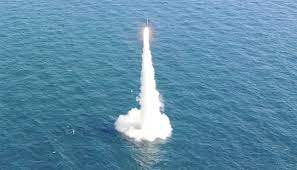
SEOUL, Sept 15, 2021 (BSS/AFP) - South Korea successfully test-fired a submarine-launched ballistic missile Wednesday, becoming only the seventh country in the world with the advanced technology and raising the prospect of a regional arms race.
The test, supervised by President Moon Jae-in, came hours after nuclear-armed North Korea fired two ballistic missiles into the sea, according to the South's military -- prompting Washington to brand Pyongyang's action a provocative "threat" to Asian neighbors.
South Korea's test is a strategic advance for Seoul. It has been strengthening its military capabilities to counter the threat posed by the North, which is under international sanctions for its nuclear weapons and ballistic missile programmes.
"It's extraordinary timing that you have not one but two Koreas testing ballistic missiles on the same day," Yonsei University professor John Delury told AFP.
"It does speak to the fact that there's an arms race in this region that everyone needs to pay attention to."
The South's missile was fired underwater from its newly commissioned submarine Ahn Chang-ho, and flew the planned distance before hitting its target, the presidential Blue House said.
With the successful tests, South Korea now has "sufficient deterrence to respond to North Korea's provocations at any time", Moon said, urging his country to continue increasing its weapons programmes to "overwhelm North Korea's asymmetric power".
Within hours he was rebuked by North Korean leader Kim Jong Un's influential sister Kim Yo Jong, who lambasted him for making a "thoughtless utterance" and incorrectly accusing the North of "provocation".
Seoul has an "illogical and stupid habit of describing its act as a just one supporting peace and describing our act of similar nature as the one threatening peace," she said in a statement carried by Pyongyang's official Korean Central News Agency (KCNA).
Earlier in the day the North fired "two short-range ballistic missiles" from South Pyongan province into the sea off its east coast, Seoul's Joint Chiefs of Staff said. Tokyo's defence minister Nobuo Kishi estimated they came down in the waters of Japan's Exclusive Economic Zone.
It was Pyongyang's second firing in less than a week, after KCNA reported it had test-fired a new "long-range cruise missile" over the weekend.
The US State Department condemned North Korea's Wednesday launch, saying it was "in violation of multiple UN Security Council resolutions and poses a threat to the DPRK's neighbors" and others.
But it reiterated its willingness to use diplomacy with the nuclear-armed North, known officially as the Democratic People's Republic of Korea, and urged them to "engage in dialogue."
- China signal -
The launches came shortly after Chinese Foreign Minister Wang Yi held talks Wednesday in Seoul with his South Korean counterpart and Moon.
Wang had earlier said he hoped all countries would help "peace and stability on the Korean Peninsula", Yonhap news agency reported.
Analysts said the timing of Pyongyang's launch was an unmistakable signal to Beijing, the North's key diplomatic ally and main partner for trade and aid -- although at times their relationship has been deeply strained.
Kim Jong Un did not visit China for more than six years after inheriting power from his father Kim Jong Il, and tensions mounted in the allies' relationship.
But he and Chinese President Xi Jinping have since met several times, and Beijing sees the North very much in its sphere of influence.
Yang Moo-jin, a professor at the University of North Korean Studies in Seoul, said Wednesday's launch "looks like North Korea's indirect message and even request to Beijing for the Korean peninsula to be addressed as a central agenda issue for China".
The United States and South Korea are treaty allies, with around 28,500 American troops stationed in the South to defend it against its neighbour, which invaded in 1950.
The impoverished North says it needs its nuclear arsenal to deter a US invasion, and its weapons programmes have made rapid progress under Kim, even without carrying out a nuclear test or intercontinental ballistic missile launch since 2017.
But it is more isolated than ever after it closed its borders early last year due to the coronavirus pandemic.
Talks with Washington have been stalled since the collapse of a 2019 summit between Kim and then-president Donald Trump over sanctions relief and what Pyongyang would be willing to give up in return.
The US, Japanese and South Korean envoys on the North met in Tokyo earlier this week when Washington's representative Sung Kim reiterated: "We hope that the DPRK will respond positively to our multiple offers to meet without preconditions."
Pyongyang has long sought to develop SLBM technology, and showed off four such devices at a January military parade, with KCNA calling them "the world's most powerful weapon".
But while North Korea has released pictures of underwater launches, analysts believe they were from a fixed platform or submersible barge rather than a submarine.